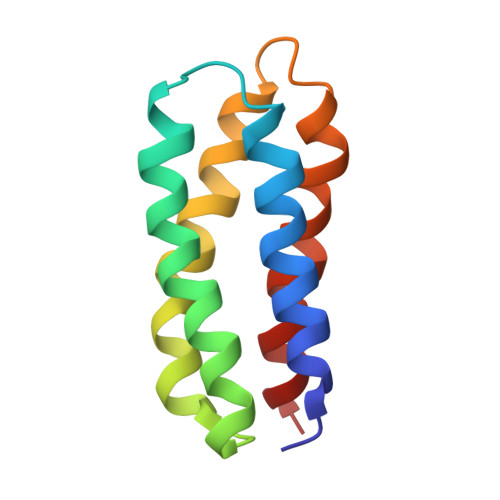Structure and dynamics of de novo proteins from a designed superfamily of 4-helix bundles.
Go, A., Kim, S., Baum, J., Hecht, M.H.(2008) Protein Sci 17: 821-832
- PubMed: 18436954
- DOI: https://doi.org/10.1110/ps.073377908
- Primary Citation of Related Structures:
2JUA - PubMed Abstract:
Libraries of de novo proteins provide an opportunity to explore the structural and functional potential of biological molecules that have not been biased by billions of years of evolutionary selection. Given the enormity of sequence space, a rational approach to library design is likely to yield a higher fraction of folded and functional proteins than a stochastic sampling of random sequences. We previously investigated the potential of library design by binary patterning of hydrophobic and hydrophilic amino acids. The structure of the most stable protein from a binary patterned library of de novo 4-helix bundles was solved previously and shown to be consistent with the design. One structure, however, cannot fully assess the potential of the design strategy, nor can it account for differences in the stabilities of individual proteins. To more fully probe the quality of the library, we now report the NMR structure of a second protein, S-836. Protein S-836 proved to be a 4-helix bundle, consistent with design. The similarity between the two solved structures reinforces previous evidence that binary patterning can encode stable, 4-helix bundles. Despite their global similarities, the two proteins have cores that are packed at different degrees of tightness. The relationship between packing and dynamics was probed using the Modelfree approach, which showed that regions containing a high frequency of chemical exchange coincide with less well-packed side chains. These studies show (1) that binary patterning can drive folding into a particular topology without the explicit design of residue-by-residue packing, and (2) that within a superfamily of binary patterned proteins, the structures and dynamics of individual proteins are modulated by the identity and packing of residues in the hydrophobic core.
- Department of Chemistry, Princeton University, Princeton, New Jersey 08544, USA.
Organizational Affiliation:
















